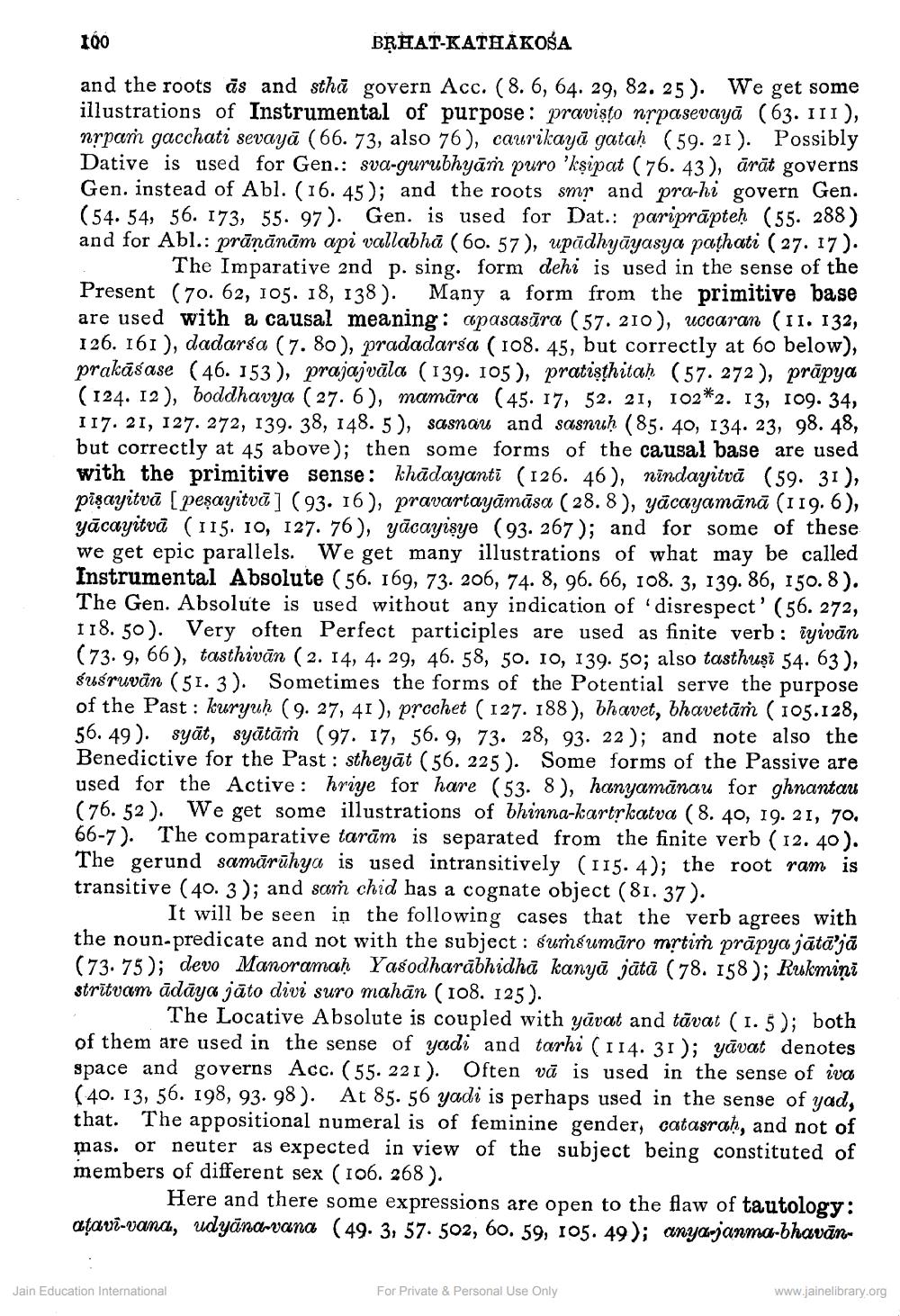________________
too
BRĦAT-KATHÁKOŠA
and the roots ās and sthā govern Acc. (8. 6, 64. 29, 82. 25). We get some illustrations of Instrumental of purpose: pravisto nrpasevayā (63. III), nrpar gacchati sevayā (66.73, also 76), caurikayā gataḥ (59.21). Possibly Dative is used for Gen.: sva-gurubhyām puro 'kşipat ( 76. 43), ārāt governs Gen. instead of Abl. (16.45); and the roots smr and pra-hi govern Gen. (54. 54, 56. 173, 55. 97). Gen. is used for Dat.: pariprāpteḥ (55. 288) and for Abl.: prānānām api vallabhā (60. 57), upādhyāyasya pathati (27. 17).
The Imparative and p. sing. form dehi is used in the sense of the Present (70. 62, 105. 18, 138). Many a form from the primitive base are used with a causal meaning: copasasāra ( 57. 210), uccaran (II. 132, 126. 161), dadarśa (7.80), pradadarśa ( 108. 45, but correctly at 60 below), prakāśase ( 46. 153 ), prajajväla (139. 105), pratisthitaḥ (57. 272), prāpya (124. 12), boddhavya ( 27. 6), mamāra (45. 17, 52. 21, 102*2. 13, 109. 34, 117. 21, 127. 272, 139. 38, 148. 5), sasnau and sasnuḥ (85.40, 134. 23, 98. 48, but correctly at 45 above); then some forms of the causal base are used with the primitive sense: khādayanti (126. 46), nindayitvā (59. 31 ), pīşayitvā (peşayitvā] (93. 16), pravartayāmāsa (28.8), yācayamānā (119.6), yācayitva (115. 10, 127. 76), yācayisye (93. 267 ); and for some of these we get epic parallels. We get many illustrations of what may be called Instrumental Absolute ( 56. 169, 73. 206, 74. 8, 96. 66, 108. 3, 139. 86, 150.8). The Gen. Absolute is used without any indication of disrespect' (56. 272, 118. 50). Very often Perfect participles are used as finite verb: iyivān (73. 9, 66), tasthivān (2. 14, 4. 29, 46. 58, 50. IO, 139. 50; also tasthuși 54. 63), suéruvān (51.3). Sometimes the forms of the Potential serve the purpose of the Past : kuryuh (9. 27, 41 ), prcchet ( 127. 188), bhavet, bhavetāṁ ( 105.128, 56. 49). Syāt, syātāṁ (97. 17, 56. 9, 73. 28, 93. 22); and note also the Benedictive for the Past : stheyāt (56. 225). Some forms of the Passive are used for the Active : hriye for hare (53. 8), hanyamānau for ghnantau (76.52). We get some illustrations of bhinna-kartrkatva (8. 40, 19. 21, 70, 66-7). The comparative tarām is separated from the finite verb ( 12.40 ). The gerund samārūhya is used intransitively (115.4); the root ram is transitive ( 40. 3); and saṁ chid has a cognate object (81. 37).
It will be seen in the following cases that the verb agrees with the noun-predicate and not with the subject : cursumāro mrtir prāpya jātājā (73.75); devo Manoramah Yasodharābhidhā kanyā jātā (78. 158); Rukmini stritvam ādāya jāto divi suro mahān (108. 125).
The Locative Absolute is coupled with yāvat and tõvat (1.5); both of them are used in the sense of yadi and tarhi (114. 31); yāvat denotes space and governs Acc. (55. 221). Often vā is used in the sense of iva ( 40. 13, 56. 198, 93. 98). At 85. 56 yadi is perhaps used in the sense of yad, that. The appositional numeral is of feminine gender, catasrah, and not of mas. or neuter as expected in view of the subject being constituted of members of different sex (106. 268 ).
Here and there some expressions are open to the flaw of tautology: atavi-vandi, udyāna-vana (49. 3, 57. 502, 60. 59, 105. 49); anya-janma-bhavan
Jain Education International
For Private & Personal Use Only
www.jainelibrary.org




